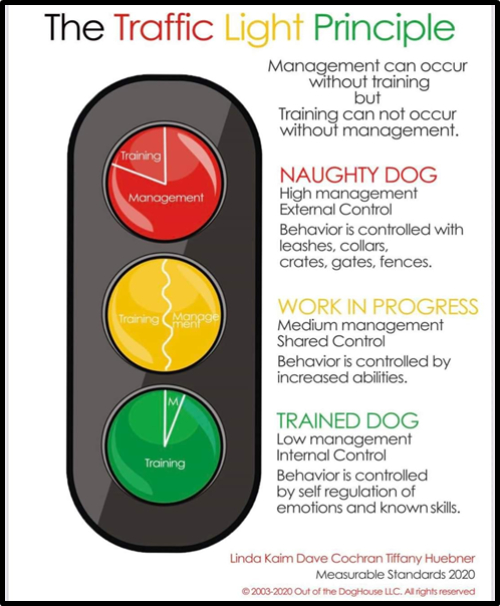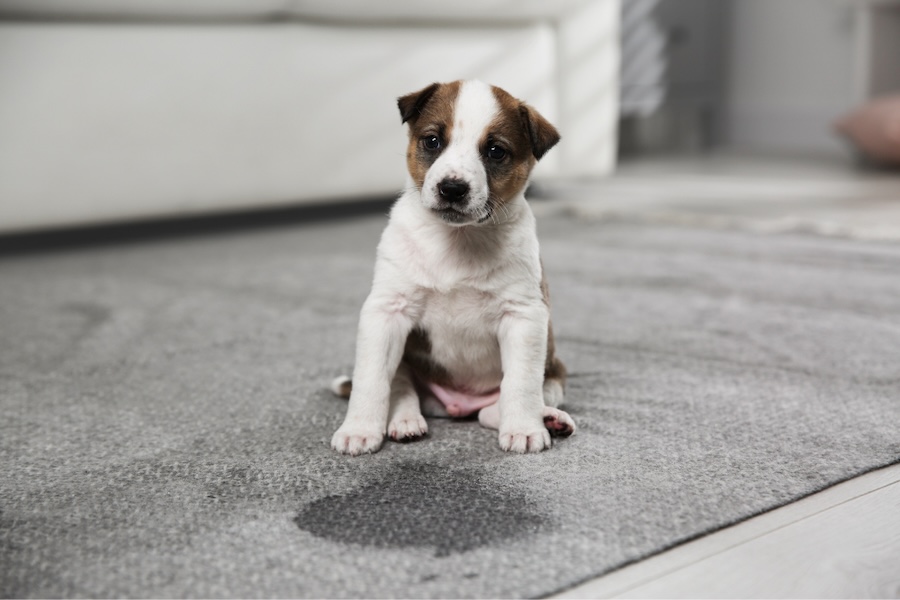Congratulations on your new puppy! Although welcoming a new puppy into the family is exciting for all, you must understand that training starts from day one and happens 24/7. Puppies aren’t going to be puppies forever and our goal when it comes to training is to have well mannered, adult dogs that can exist within the environments they will encounter over their lifetime. Communicating with your dog appropriately and effectively will make creating a partnership with your dog fun and rewarding. How do we communicate? A leash and collar are a necessity when training. You can guide your puppy right from wrong and prevent them from getting into trouble. Leashes aren’t just for going outside so leashing your puppy inside the home as well will set you up for training success!
CRATE TRAINING: Crate training your puppy will be the most valuable tool in dog ownership. Puppies cannot handle having free reign of the house without supervision. Utilizing the crate will prevent your puppy from chewing/ingesting items, going to the bathroom in the house, and teaching your puppy boundaries and rules within the house. Puppies should be crated ANYTIME you are unable to supervise whether it’s 5 minutes or 5 hours. Also crate your puppy while you are home, so it isn’t always associated with you leaving the house, and throughout the night while sleeping. Here are some additional tips to make the crate an enjoyable place for your puppy to be:
- Feed all meals in the crate.
- Leave crate safe toys with the puppy so they can chew/teeth.
- Be mindful of the bedding you use. Usually, the fluffier the bedding the more puppies will be encouraged to destroy it.
- Keep the crate door closed 100% of the time. Leaving the door open for your puppy to go in and out of it freely can create a barking, demanding puppy once the crate door is closed.
- While you’re home and able to supervise, give bones/chews your puppy doesn’t normally get. This can be a bully stick, stuffed kong, anything that your puppy really enjoys playing with but you can’t leave them alone with while you aren’t around.
You should plan a solid 2 years of strict crate training before you start to give more freedom to your dog. Some dogs can be sooner, and some dogs will be never.
POTTY TRAINING: Crate training and potty training go hand in hand. Using the crate limits the freedom your puppy has to find areas around the house to eliminate. Keeping to a strict potty schedule will be much easier when you have a crate to help manage where your puppy goes. A good way to gauge how often your puppy needs to go out is 1 hour per month of age. For example, a 2 month old puppy will need a break every 2-3 hours, a 3 month old puppy will need a break every 3-4 hours, etc. This rule applies for during the day as well as during the night. Getting into a good routine will help your puppy regulate themselves more efficiently and you’ll have less accidents to clean up! If you find your puppy is still having accidents, then you need to manage your puppy’s freedom better and keep a closer eye on it. Once your puppy is mature enough, most dogs can break every 6-8 hours on a routine basis. Lastly, regulating your puppy’s water intake will help potty training go more smoothly. Offer your puppy water throughout the day instead of leaving it out 24/7 (including within their crate). Offer it after feeding, playing, being outside, after coming out of their crate, etc.
***NEVER USE WEEWEE PADS – If you don’t want your dog to be eliminating inside your home, don’t encourage it by putting weewee pads down.***
EXPOSURE VS SOCIALIZATION: There is a huge misunderstanding when it comes to “socializing” your puppy. Owners often think that bringing your puppy to dog parks, daycares, and places where people constantly fuss on your puppy is proper socialization. The problem with this is that all this excessive attention from elsewhere other than the owner makes all these other things more valuable than yourself. Therefore, we see so many reactive, anxious, rude dogs out and about because all of these things have been very reinforcing and fun for the dog to a point that the dog becomes easily excitable and frustrated when on leash. A dog should be neutral in distracting environments and look to their owners for guidance. Exposing your dogs to the environment around them without the need to constantly interact with it is what will give you a more a confident and relaxed dog. Save interactions for people and other dogs you know and trust or work with a trainer to that will provide appropriate socialization for your puppy.
PUPPY BITING: Puppy biting comes with the territory of puppy owning. Puppy biting is usually just teething so it’s important they have access to appropriate chews/toys to satisfy that urge. Teaching your puppy that clothes, shoes, furniture, TV remotes, wooden chairs, your body, and anything else they can get their mouths on are a definite NO and only the toys provided are allowed to be chewed on. Again, managing your puppy’s freedom will prevent your puppy going off to chew on items they are not supposed to be chewing on! If you catch your puppy in the act of chewing on something they shouldn’t be, correct the puppy for doing so and then give them a toy they are allowed to chew on. Puppy biting is also a sign your puppy may not be getting enough sleep throughout the day. Make sure they have periods of down time within their crate to nap and relax, even if you are home!
RESTRAINT: Getting your puppy used to being restrained with grooming and vet visits will make these procedures less stressful for everyone involved. All dogs will see a vet at least once a year and will undergo grooming to some extent. What can you do to get your puppy used to being handled?
- Touch/pinch the paws to prepare for toenail trims (this should be done weekly, if not, daily until your puppy is comfortable). Trim the nails, even if they don’t really need it!
- Check your puppy’s teeth.
- Check the ears by looking down into them and gently poke your finger inside.
- Check the eyes by looking into them and gently pulling the lids back.
- Teach your puppy to sit/stand still on a table-top or some sort of elevated surface to imitate being on the exam/grooming table.
- Get your puppy comfortable laying on their sides as this is a common position a lot of dogs find themselves in during veterinary diagnostics (x-rays, ultrasounds, possible blood draws, etc.)
Below is a great layout of what training looks like when owning a dog. Puppies require a high amount of management to enforce good behaviors, and not let undesirable behaviors get out of hand. Dog are living beings you can’t just download training information into like an app on a phone. Training doesn’t end after a 6 week obedience course or a few months of behavior rehab. You must put in the work to train first and then maintain over the course of the dog’s life!



